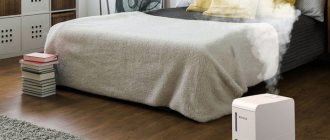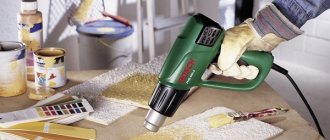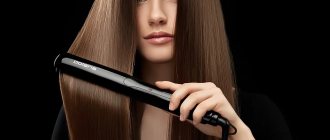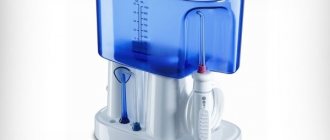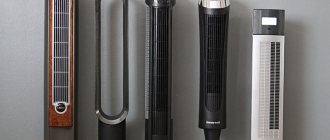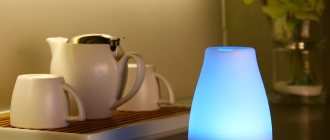The health and beauty of your teeth largely depends on how carefully your oral hygiene is maintained. Cleaning teeth from food debris and plaque with a toothbrush, due to the complexity of the dentition, the presence of hard-to-reach areas, and interdental spaces, is not effective enough. Dentists have long used irrigation in their professional practice to clean teeth. Now the home arsenal of dental care products has been replenished with a new device - an oral irrigator.
Why do you need an irrigator?
Irrigator is a derivative of the Latin word irrigatum, which means “to irrigate.” This is a device that allows you to use water to clean your teeth from organic residues remaining in the mouth after eating. The irrigator does not replace the action of a toothbrush. An irrigator is especially necessary when wearing orthopedic devices (bridges, brackets, brackets and others). With its help, structural elements and the surface of the teeth that come into contact with them are cleaned.
Cleaning braces with an irrigator
Irrigators with special attachments are considered the most effective way to clean braces and keep your mouth clean while you wear them. When cleaning braces, you should follow a few simple rules.
- Start with the far teeth
. - Clean each bracket separately
. Pay special attention to the clasps and structural elements that fit tightly to the enamel. - After this, move on to the interdental space and gums
.
It would also be a good idea to use special balms and irrigator solutions, including antiseptic ones, since lips and cheeks often become inflamed while wearing braces.
Operating principle of the irrigator
The principle of operation of the irrigator is based on the flow of a very thin stream of water under high pressure onto the elements of the oral cavity to be cleaned. This method of treating the oral cavity not only washes out the smallest food debris and removes plaque from the teeth, but also massages the gums, which improves blood circulation. The device consists of a hydraulic pump, a container for liquid and a handle with replaceable nozzles.
The reservoir is filled with water or solution, under the action of the compressor the pressure rises, and the liquid rushes to the handle with the nozzle. Different irrigator models provide a variety of water jet supply modes, which can be pulsating, spraying, constant, centered, or spraying. The liquid used is plain water or solutions with added agents that enhance the therapeutic and preventive effect of the procedure. Solutions of fluoridated, calcined liquid, antiseptics, antibacterial drugs, herbal infusions, and compositions for strengthening gums are used. Special attachments on the handle ensure that the water jet reaches areas of the dentition that are inaccessible to a toothbrush and floss.
How to use an irrigator correctly
At first, it is recommended to set the device to the weakest setting so as not to damage soft tissues and cause pain. During cleaning, the handle of the device should be held at an angle of 90° to the surface of the teeth. You should tilt your head so that the liquid will immediately flow into the sink. How often you need to use an oral irrigator, the number of daily procedures and their duration depend on the individual characteristics of the owner of the device. For some, it will be enough to use the irrigator no more than 3 - 4 times a week for 5 minutes daily, while for others, for example, those who wear braces, crowns, implants or other structures or suffer from crowded teeth, to achieve the desired result, you should wash your teeth at least twice a day for 10-15 minutes. In any case, the plan for using the irrigator must be approved by a specialist.
By the way, some devices have a sensor installed that helps to organize the cleaning process correctly. Based on the time given to him, he independently plans the course of the procedure and “informs” his owner when he needs to move from the treated area of the oral cavity to the untouched one.
The Panasonic Dentacare Handy EW 1211 portable irrigator is one of the best devices in terms of reliability.
Benefits of an irrigator
The benefit of the irrigator is better cleaning of the oral mucosa, surface of the teeth, interdental spaces, as well as orthopedic structures. And the absence of a biological substrate for the proliferation of bacteria and the rotting of food debris is the prevention of the development of dental diseases. Medical studies have found that a three-second treatment with pulsating water using an oral irrigator removes up to 99.9% of bioplaque on teeth.
Oral irrigator features:
- Significantly reduces the risk of developing caries.
- Promotes rapid healing of gums through micromassage.
- Disinfects and refreshes the oral cavity with antiseptic solutions.
- Cleans gum pockets and prevents the development of periodontal disease.
- Treats the oral mucosa with medicinal solutions for stomatitis
- Prevents the deposition of pigment on the surface of tooth enamel when smoking, drinking strong coffee, tea, red wine.
- Removes plaque from the mucous membrane of the tongue and gums, which reduces bacterial contamination of the oral cavity.
- Prevents destruction of the enamel coating of teeth when installing braces, braces and other orthopedic devices.
- To reduce trauma to soft tissues due to bleeding and loosening of the gums, replace the toothbrush.
What are the benefits of using an irrigator?
Choosing the right device and using the irrigator in accordance with your doctor’s recommendations brings significant benefits to your health.
- Effectively removes plaque in difficult areas.
A layer of plaque forms on the teeth every day, which serves as an ideal environment for bacteria to multiply. If this plaque is not carefully removed, it gradually thickens, the enamel surface darkens, microbes destroy the tooth structure, and provoke the development of gum disease. The pulsating stream of water supplied by the irrigator easily removes plaque even where a toothbrush cannot cope - in the interdental space, under dental structures. Thus, the use of this device prevents the proliferation of microbes in the oral cavity.
- Provides a gentle massage of the gums.
The water jet, acting on the gums, strengthens blood vessels, reduces bleeding and sensitivity, and reduces the risk of developing inflammatory diseases.
- Does not injure gums.
Unlike dental floss, which can damage the gums, cause bleeding and pain, the irrigator is gentle on the soft tissues of the oral cavity and does not injure the gums.
- Thoroughly cleans gum pockets.
With periodontitis and a number of other diseases, gum pockets—the cavity between the tooth and the gum—enlarge. It is very difficult to clean this pocket with a brush and paste; as a result, microbes actively multiply there, which leads to the progression of the disease. Using a periodontal irrigator nozzle with a soft rubber tip, you can carefully and effectively clean gum pockets without damaging your gums.
- Helps care for braces, dental implants, crowns, bridges.
People who wear dental appliances need especially careful oral care. In addition to cleaning your teeth and gums, it is important to clean the orthodontic clasps of braces and the space under bridges and crowns from dirt. The irrigator copes well with such tasks, removing food debris and dirt without harming dental structures.
- Reduces bad breath.
One of the common causes of bad breath is poor oral hygiene and, as a result, caries, dental plaque, and inflammation in the gums. By regularly using an irrigator, you can get rid of the unpleasant odor in a matter of days. The process will be even more effective if, instead of regular water, you use medical liquids recommended by your doctor to clean your mouth.
- Serves as a prevention of dental diseases.
The irrigator provides comprehensive cleaning of the teeth and oral cavity, significantly improves the quality of hygiene and thereby reduces the risk of developing caries, periodontitis, stomatitis, gingivitis and other dental diseases.
Types of irrigators
Types of irrigators differ from each other in technical characteristics, design, and operating principles. Stationary models are placed in the bathroom and operate from the mains. They are equipped with a large capacity for liquid and have a powerful engine that creates a high level of pressure. The device is usually used by the whole family, so it comes with many attachments.
Which dental irrigator should you choose?
Irrigators are either stationary or portable. The first ones have a large (up to a liter) reservoir for liquid, operate from an electrical network, and are distinguished by high power. Portable ones are light in weight, have a tank capacity of around 400 ml and run on batteries.
If you plan to frequently use a water flosser at home, it is better to choose a stationary model that does not need to be recharged, and one tank is enough for use by several family members. If you need a dental irrigator on trips or business trips, a portable model is better suited for these purposes. This device easily fits into a travel bag and can be used if there is no power outlet nearby.
Flaws:
- The energy source is too small to create the required water jet pressure.
- The need to frequently replace batteries or charge the battery.
- The volume of water is not enough to fully clean the oral cavity.
- Flow irrigators are attached to a water tap and use the pressure of the water supply system. Special tap valves allow you to regulate the fluid pressure.
- Mechanical types of irrigators are now rarely used. These are devices in which the pressure required to produce a jet is achieved by mechanical action on the piston. There is a key on the body of the device that is pressed to increase the pressure in the vessel with the liquid. The efficiency of such a device is low
- Tap water mixed with chlorine and heavy metal salts enters the oral cavity.
- There is no pulsation mode.
- Often the water pressure is not enough for effective cleaning.
- Modern models use the latest fine-bubble cleaning method, which is considered the most effective.
- The pulsation mode also promotes the rapid removal of microparticles of organic substances from teeth and orthopedic structures.
Are all devices the same?
Depending on the type of power supply, stationary, portable and flow-through devices are distinguished.
The first one runs on mains power and therefore requires installation near an outlet. The second one is powered by a battery or batteries; you can take it with you on trips and travels.
The flow type is connected directly to the water tap. Its main drawback is the inability to use purified water and special medical solutions.
How are irrigators different?
When choosing a device, you should pay attention to:
- Jet pressure. The larger it is, the better the result will be achieved, but too much pressure can cause discomfort and even harm. Therefore, choose a device with the ability to change power in order to select a comfortable mode for performing the procedure.
- Availability of special settings and additional functions. For example, a pulsating jet for gum massage or microbubble technology.
- Number and types of attachments (for teeth, tongue, gum tissue, braces, veneers and other structures).
- The volume of the tank for medical solution or ordinary water. A small container will require adding liquid during the procedure, and a large device cannot be taken with you on trips and travels.
- Battery capacity, operating and charging time when choosing a portable analogue.
If you plan to use the device for all family members, then you should choose a stationary type of irrigator. It has many attachments and a large liquid reservoir. For individual use or for frequent trips and travel, its portable counterpart would be the best choice. When purchasing it, pay attention to the operating and charging time of its battery.
If you plan to use the device only for thorough oral hygiene, choose a simple mono-jet device.
When wearing braces, veneers, bridges and other structures, make sure that the orthodontic attachment is included in the package. In some cases it can be purchased additionally. For the treatment of chronic gingivitis and periodontitis, we recommend using a regimen with microbubble technology.
Types of removable attachments
Several types of attachments have been developed to perform various oral hygiene tasks:
- The standard one is used for daily brushing of teeth.
- Periodontal is designed to cleanse gum pockets.
- Nozzle for removing plaque from the tongue.
- The orthodontic attachment is used to care for braces and other dental devices.
- The brush attachment performs the work of a classic toothbrush and massages the gums.
- The teeth whitening attachment is used in the process of cleaning and polishing the enamel.
- Manufacturers of irrigators and their features
- In the modern market of dental devices, irrigators are presented in a wide range.
How often should you use a waterpik?
Experts differ in answer to this simple question. The only thing that dentists are unanimous about is that it all depends on the condition of the oral cavity and for what purpose you are going to use the irrigator - preventatively or as part of complex therapy.
For healthy teeth
If you take care of your teeth and do not neglect daily personal hygiene, then it is enough to use the irrigator once a day for 4 days a week - solely for the purpose of preventing the formation of tartar in hard-to-reach places.
For people with bad habits
For heavy smokers, as well as those who like to abuse black coffee, tea or red wine, who are prone to the formation of dense plaque, dentists recommend using an irrigator 2 times a day every day as the final stage of oral hygiene.
During pregnancy
Women expecting a baby are extremely susceptible to any infection. Therefore, to prevent the activation of bacteria that cause caries, an irrigator is indispensable at least once a day.
For gum diseases
If you have chronic inflammatory gum diseases, such as periodontitis or gingivitis, the frequency of use of the irrigator, especially a special periodontal attachment, should be regulated by the periodontist who is observing you.
When wearing braces
Modern brace systems, despite their dramatic progress compared to the designs of 20 years ago, require increased hygiene. In this situation, it is advisable to use an irrigator after each meal during the day.
If you have dentures
The situation is similar with any removable dental prostheses: the more often and thoroughly their hygiene is carried out using an irrigator, the better and longer they will last.
Attention!
After undergoing surgical interventions in the oral cavity, the use of an irrigator should be abandoned until the time when the attending physician allows it.
Dentist advice
Before you start using the device, you need to consult a dentist who will help you choose the optimal fluid supply mode, frequency of use, and solution composition. Compliance with all operating rules is the key to safe use of the irrigator. Rules for using the irrigator:
- Cleaning should begin with a gentle regime, gradually increasing power over 7-10 days.
- It is not recommended to use the device earlier than 24 hours after installing any orthodontic structures in the oral cavity.
- The liquid stream should be directed towards the teeth at a right angle.
- It is permissible to use an irrigator for children from 6-7 years of age, always under adult supervision. A high-pressure jet of water entering a child's windpipe can cause tracheal spasm and asphyxia.
- Long-term use of aseptic solutions can disrupt the normal microflora of the oral cavity and cause dysbacteriosis.
- The device can be used for gingivitis and periodontitis only during remission.
- The duration of the procedure is 5-10 minutes.
How to clean the irrigator after use?
Regardless of whether you use the device often or occasionally, after each brushing of your teeth with an irrigator, you must pour out the remaining liquid from the reservoir so that germs do not accumulate in it. Having finished the hygiene procedure, turn off the device, remove the nozzle and pour the remaining solution or water from the container.
Be sure to rinse and dry the irrigator as thoroughly as possible.
The used attachment must be washed with liquid soap, rinsed under running water and wiped clean with a dry cloth.
Do not use boiling water to clean and disinfect the device, because hot water can cause damage and deformation of the device body.
The most popular balms for irrigator
“Terasol” (antimicrobial effect), “Denfil” (alcohol-free balm, acceptable for use in children), “Asepta” (caries prevention), “Irix” (non-foaming balm with menthol to freshen breath).
The use of tap water is extremely undesirable due to the risk of device failure, since this water contains sedimentary components.
If it is impossible to use balsamic liquids, you can use boiled or special purified water.
How difficult is the device to use?
We've looked at what an irrigator is for, now let's talk about how to use a home device for cleaning your teeth. By following the operating instructions and the recommendations presented below, you will easily master the skills of its use. Even small children can cope with this.
User manual:
- Brush your teeth and rinse your mouth.
- Pour ordinary boiled water or medical solution into a special container.
- Turn on the irrigator.
- Select the desired mode or adjust the jet pressure.
- Place the nozzle of the nozzle perpendicular to the gum.
- Treat each tooth and interdental space from all sides.
- Rinse your mouth.
- Turn off the device.
The described algorithm is only suitable for a stationary device. For a portable analogue, the sequence of actions will be slightly different.
If you still have any questions, contact a dental specialist. Our doctors will not only give recommendations for use, but also, if necessary, prescribe a medical solution that is suitable for you.
